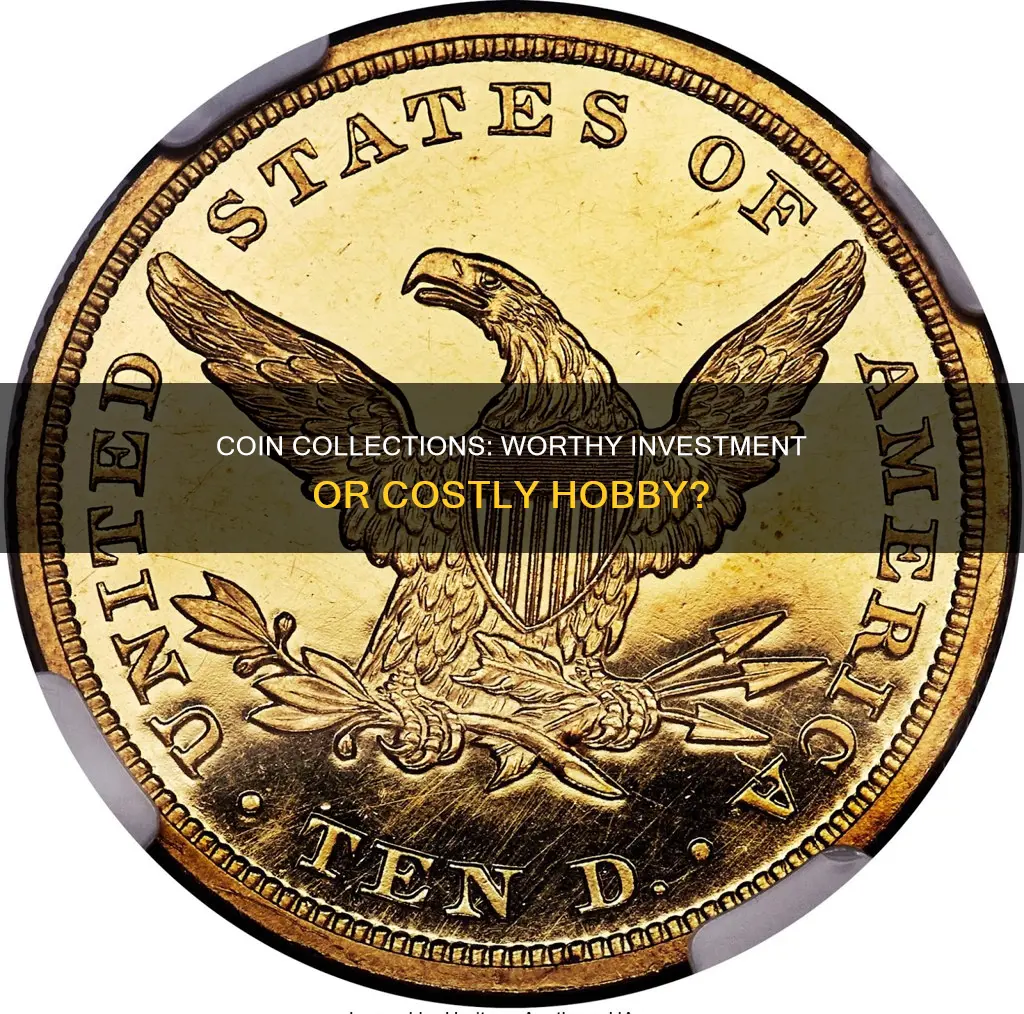
Coin collecting is a popular hobby for people of all ages and backgrounds, who enjoy the thrill of the chase for rare coins, the historical significance of antique coins, and the beauty of the coins themselves. But is it a good investment? Coins derive their value from two sources: the physical metal they contain, and their collector or numismatic value. The former is easier to calculate, while the latter is harder to determine as it depends on buyer sentiment. Coins can be a profitable investment when done right, but there are many pitfalls to be aware of, such as the huge markups often charged by dealers.
| Characteristics | Values |
|---|---|
| Type of coin | Coins can be circulated or non-circulated. Non-circulated coins include commemorative coins and bullion coins. |
| Metal composition | The metal a coin is made of can make it more valuable than its denomination. For example, a gold 50p coin is worth more than a 50p coin made of cupro-nickel. |
| Finish | Coins with a superior finish are more valuable. Circulated coins are struck once, whereas bullion coins have a similar finish but are made from precious metals and have no blemishes. Commemorative Brilliant Uncirculated coins are struck twice, and Proof coins are struck several times. |
| Rarity | The fewer examples of a coin that were minted, the higher its collector value. Coins with rare dates and mint marks are more valuable. |
| Condition | A coin in uncirculated condition is worth more than one that has been circulated. |
| Age | Older coins are often more valuable. |
| Historical significance | Coins with historical significance are more valuable. |
What You'll Learn

Coins with historical significance
Firstly, it's worth noting that the value of a coin comes from two main sources: the physical metal it contains and its collector or numismatic value. The former, also known as its bullion value, is determined by the amount of precious metal in the coin, such as gold or silver. The latter, on the other hand, is harder to determine and depends on factors like rarity, age, and condition.
When it comes to historical coins, their numismatic value often plays a bigger role in their overall price. For example, the Brutus "Eid Mar" Denarius coin, minted in 42 BC, is one of the most important ancient coins. It commemorates the assassination of Julius Caesar, with daggers on one side and a portrait of Brutus, his assassin, on the other. Due to its historical significance and rarity, this coin is highly valued by collectors.
Another example is the Athens Decadrachm, minted between 460-430 BC. This coin was struck to commemorate the Greeks' victory over the Persians in battles like Thermopylae and Marathon. With Athena on one side and an owl, her symbol, on the other, this coin is an important piece of ancient history.
The Decadrachms of Syracuse, minted between 400-390 BC, are also considered fine examples of numismatic art. These coins feature intricate designs, such as the water nymph Arethusa surrounded by dolphins and a quadriga, representing the four tyrants of Syracuse.
The Akragas Decadrachm, minted in 411 BC, is another rare ancient coin. With fewer than ten known to have survived, it likely commemorated an Olympic chariot race victory. The front depicts the sun god Helio in his chariot, while the back shows two eagles over a hare.
Finally, the Gold Stater of Croesus, minted in 550 BC, is the first pure gold coin ever created. It features a bull and a lion facing each other and was minted by King Croesus of Lydia to solve the problem of varying precious metal content in the naturally occurring alloy electrum.
These ancient coins, with their rich histories and limited numbers, are highly sought after by collectors, making them a potentially good investment. However, it's important to remember that the market for rare coins can be unpredictable, and it's always a good idea to consult experts and do your own research before making any significant purchases.
Strategies for Crypto Investment Without Coin Purchase
You may want to see also

Rare coins
Firstly, the value of a coin is derived from two main sources: the bullion value, or the value of the physical metal contained in the coin; and the collector or numismatic value, which is influenced by factors such as rarity, condition, and buyer sentiment. The bullion value is relatively easy to calculate, whereas the collector value can be more challenging to determine and is influenced by more subjective factors.
When investing in rare coins, it is generally recommended to focus initially on the bullion value, as it is a more straightforward investment. Modern bullion coins, such as Canadian Maple Leaf silver coins and American Gold Eagles, are a great way to start investing in this area. These coins contain high-grade gold or silver, making them excellent precious metal investments.
However, investing in rare coins can be very profitable if done right. The key factors to consider when investing in rare coins are rarity, mint marks, and minting errors. The fewer examples of a coin that were minted, the higher its collector value is likely to be due to limited supply. Additionally, rare minting errors can significantly increase the value of a coin. It is also important to deal in certified coins, which have been inspected and graded by a recognised organisation, to ensure authenticity and protect your investment.
It is worth noting that investing in rare coins is a long-term strategy and may not be suitable for those seeking short-term profits. The rare coin market can fluctuate, and it may take time to earn a significant profit. Additionally, it is important to be aware of the potential for counterfeit or doctored coins, which can be misrepresented in terms of their condition and value.
In conclusion, investing in rare coins can be a profitable venture, but it requires knowledge, research, and a long-term perspective. It is important to find a mentor, educate yourself, and connect with other numismatists to make informed investment decisions in this field.
TD Ameritrade: Buying Bitcoin Investment Trust Guide
You may want to see also

Coins with bullion value
Bullion value is distinct from collector or numismatic value, which is determined by buyer sentiment and is influenced by factors such as rarity and the condition of the coin. While bullion value is based on the intrinsic value of the metal content, numismatic value is driven by the demand for specific coins among collectors.
Bullion coins are produced by various mints, including the United States Mint, foreign government mints, and private mints. To be considered a bullion coin, it must be minted under the authority of a recognised government. Examples of bullion coins include the South African Krugerrand, the American Silver Eagle, and the American Gold Eagle. These coins are valued for their precious metal content and are often sought-after by investors looking to diversify their portfolios.
Investing in bullion coins can be a profitable venture, but it is important to do your research and understand the market. The value of bullion coins is closely tied to the spot prices of precious metals, which fluctuate over time. Additionally, it is worth noting that some bullion coins may also have a numismatic value component, which can influence their overall price.
Overall, coins with bullion value offer investors a way to invest in precious metals while also owning a tangible asset. By understanding the factors that drive bullion value and staying informed about the precious metals market, investors can make more informed decisions when adding bullion coins to their portfolios.
How to Invest in Bitcoin Fractions
You may want to see also

Numismatic value
The numismatic value of a coin is the price you can expect to receive through its sale. This value is determined by factors such as scarcity, condition, supply, and demand. Even coins with high issue rates can be scarce, increasing their demand and value over time as they become harder to find.
The condition of a coin is graded on a scale of 1 to 70 by experts, with 70 being a flawless coin. The supply of a coin is influenced by factors such as hoarding, economic instability, and political unrest, which can decrease supply and benefit collectors. Demand for a coin can be driven by characteristics such as quality, rarity, and history.
Coins with numismatic value include the American Eagle Gold Proof coin, which is minted in limited quantities and is considered one of the most beautiful coins in the world. Its weight and purity are backed by the U.S. government, and it can be easily sold for cash at precious metal dealers worldwide. Another example is the Silver Proof 50p coin, which is worth more than its face value due to its composition of precious metal and superior finish.
When investing in coins with numismatic value, it is important to consider the overall coin market, which can be volatile. Rare coins, in particular, can have dramatic short-term price swings due to their lower sales volume and greater variations in sale prices. Additionally, it is recommended to deal only in certified coins when investing in coins purely for their numismatic value. Certified coins have been inspected and graded by recognised organisations and are placed in protective holders.
The Ultimate Guide to Investing in Bitcoin Stock
You may want to see also

Coins as a financial asset
Coins can be a financial asset, but it is important to understand the different types of coins and their value. There are two types of coins: circulating coins and non-circulating coins. Circulating coins are the coins that are used in everyday transactions, while non-circulating coins include commemorative coins and bullion coins.
The value of a coin comes from two main sources: its bullion value and its collector's value, or numismatic value. The bullion value of a coin is based on the physical metal contained in the coin. Precious metals such as gold or silver give coins an intrinsic value. The bullion value can be calculated by multiplying the number of ounces of metal in the coin by the current price per ounce of that metal.
The second source of value, the collector's value, applies mainly to antique and rare coins. It is influenced by factors such as scarcity and the condition of the coin. The fewer the number of coins minted and the better the condition, the higher the collector's value.
When investing in coins, it is generally recommended to focus on bullion value, especially for beginners. Modern bullion coins, such as Canadian Maple Leaf silver coins and American Gold Eagles, are a great way to start. These coins contain high-grade gold or silver, making them excellent investments for their metal content. They are also aesthetically pleasing, which is an important factor for collectors.
Older coins can also be good investments for their bullion value. For example, American quarters and dimes minted before 1965 contain 90% silver and are often purchased by investors. Some coins, like American silver dollars, fall between being bullion investments and numismatic investments. They may not have immense collector value, but they sell for prices higher than their raw bullion value.
For those interested in the numismatic value of coins, it is important to know which coins will be in high demand among collectors. Rare dates, mint marks, and minting errors can all contribute to a coin's numismatic value. Certified coins, which have been inspected and graded by recognised organisations, are recommended for numismatic investments.
It is worth noting that the difference between the buying and selling prices of collectible coins can be significant, and this can impact the potential returns on investment. Additionally, it is important to be cautious of dealers selling coins at exorbitant prices, as some sources warn against buying from TV shopping networks, certain mints, and dealers who market common coins as rare.
Overall, while coins can be a financial asset, it is important to do your research and understand the different factors that influence their value.
Silver Coin Investment: Best Buys for Your Money
You may want to see also
Frequently asked questions
Coins derive their value from two sources: the physical metal they contain (bullion value) and their collector/numismatic value. The bullion value of a coin can be calculated by multiplying the number of ounces of metal in the coin by the spot price per ounce of that metal. The collector value of a coin depends on buyer sentiment, but generally, the fewer examples of a coin that were minted, the higher its collector value. The condition of the coin also plays a major role in its collector value.
According to experts, the best types of investment coins are rarer, key date coins issued by the United States, in the best grade you can afford. If these are out of your budget, you can purchase common coins in the finest grades you can afford. Numismatists and coin experts believe that most types of U.S. nickels are undervalued. For obsolete coins, most Walking Liberty, Franklin, and silver Kennedy Half Dollars are underrated.
Coins sold by TV shopping network "coin dealers" and premium "mints" are often priced several times higher than if they were purchased from a reputable coin dealer. Coins issued by the National Collector's Mint, such as the "Freedom Tower" coins, imply that they contain meaningful amounts of precious metal when they do not. Coins and medals from the Franklin Mint and other premium collectibles mints, such as the Bradford Exchange, are also poor investments as they usually do not have any premium aftermarket value among coin collectors and investors.







